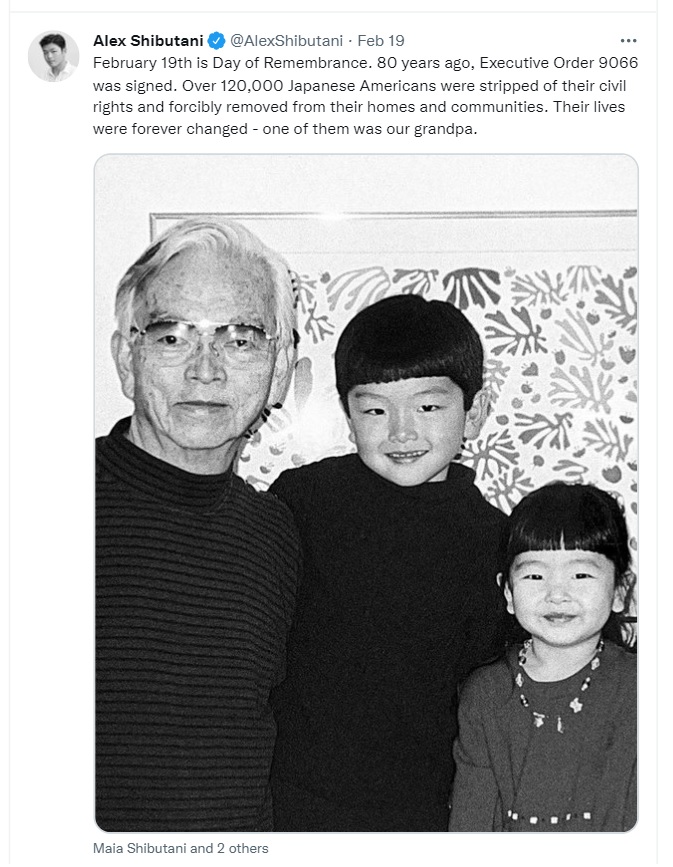| | | “Remember the concentration camps, stand for redress with your family.” By Frances Kai-Hwa Wang I found a photograph of a young Mike Masaoka at the Mississippi Civil Rights Museum last week. He was with his three brothers, in uniform, at Camp Shelby, Mississippi. Masaoka was an important but controversial Japanese American leader, often blamed for the Japanese American Citizens League (JACL) urging Japanese Americans to go quietly into the World War II concentration camps to prove their loyalty to America. The 442nd Regimental Combat Team and the 100th Infantry Battalion trained together — and often fought each other — at Camp Shelby. Although they were all young Nisei (second generation Japanese Americans), there were huge cultural and experiential differences between the mainland Nisei (whose families were incarcerated in concentration camps) and the Hawaii Nisei (who had grown up in multicultural Hawaii and whose families were largely not incarcerated). The Japanese American men were also horrified by the anti-Black racism and segregation that they witnessed in Mississippi, where German POWs had better facilities and more privileges because of the Geneva Convention than Black U.S. soldiers in uniform. However, according to Densho, their outbursts and interventions on behalf of African Americans resulted in reprimands and reminders that they could not end Jim Crow on their own. What brought the mainland Nisei and the Hawaii Nisei together is a trip organized for the Hawaii Nisei to visit Rohwer and Jerome concentration camps in Arkansas. They thought they were going to meet Japanese American families, eat Japanese American food, and dance with Japanese American girls, but they were shocked when they saw the barbed wire fences and finally understood the reality of the camps. After that, the young men of the 442nd and 100th were united and went on to become the most highly decorated military unit of its size, even to this day. I first learned about Camp Shelby and that historic visit from a musical put on by the Grateful Crane Ensemble, not from any history book. Last week was also the Day of Remembrance and the 80th anniversary of FDR’s Executive Order 9066 which called for the incarceration of 120,000 Japanese Americans, 2/3 of whom were U.S. citizens, during World War II. The first Day of Remembrance was organized by Asian American artists Frank Abe, Frank Chin, and others in 1978 as a bit of street theater which emphasized both remembrance and taking action. “Remember the concentration camps, stand for redress with your family.” Japanese American families caravanned to Seattle’s Puyallup Fairgrounds, where they had been incarcerated in 1942, and as they drove there, many Nisei began talking to their families about the camps for the first time. This year’s Day of Remembrance was also marked by calls for action, art, and solidarity with other communities. Allyship is not easy, and these stories show that even among the same ethnic group, even in the same family, allyship is not automatic. It starts with reaching across differences to learn and better understand each other, not banning books and critical race theory (which is not taught in K-12 schools). Another approach: In Mississippi, every student visits the Mississippi Civil Rights Museum at least once during their K-12 education. Some of the reporting for this essay was made possible by the Nissan Foundation. |
| |
|
| | 'Nowhere is safe': Asian women reflect on brutal New York City killings | NBC Asian America Asian women who live in New York City say they’re standing back from the subway edge and walking home with pepper spray in their hands after the killings of Michelle Go and Christina Yuna Lee. Remembering Linsanity by Jeremy Lin | The Ringer In an exclusive, illustrated excerpt from the upcoming book ‘RISE,’ Jeremy Lin remembers his road to the NBA and reflects on where Linsanity led THROUGH THE FIRE: Remembering the First Day of Remembrance by Sharon Yamato | Rafu Shimpo “Remember the concentration camps, stand for redress with your family.” WATCH: Olympic great Apolo Ohno on this year’s ‘unprecedented’ Winter Games | PBS NewsHour Amna Nawaz gets the perspective of former speed skater and Olympic great Apolo Ohno Analysis: China would back Russia, diplomatically, if it moved on Ukraine | Reuters China would back Russia diplomatically and perhaps economically if it invades Ukraine, but would stop short of providing military support, experts said. The mystery of the chained woman in China | NPR A video showing her chained inside a shed got nearly 2 billion clicks and has sparked a national debate over her identity, whether she is mentally ill, and whether she was trafficked as a bride. For Asian American women, Olympics reveal a harsh duality | ClickonDetroit Phil Yu, Angry Asian Man: "Oh sure, it’s always 'go back to your country' but not 'go back to your country and win a gold medal.’" ESSAY by Jeff Yang: Here’s why your shoes will be staying the hell out of my house | The Guardian The Wall Street Journal essay about keeping shoes on left me aghast. As my Auntie Chih-Mei put it: ‘When you walk into my house wearing shoes, you are walking across my heart.’ Advancing Justice – AAJC Commends End to China Initiative, Calls for Transparency and Vows to Watch Dismantling Closely | Advancing Justice AAJC The U.S. Department of Justice announced an end to the controversial “China Initiative” and a series of changes to their national security approach to address concerns of profiling of Asian Americans. Also CAPAC Members Welcome End of China Initiative |
| |  | | |
|
| | - NEW VIDEO: U.S. AND CHINA AND TECHNOLOGY – Forty years after the signing of the 1979 U.S.-China Science and Technology Cooperation Agreement, it seems that the honeymoon is over and it’s time for the U.S. and China to seek counseling for their strained relationship. We look at the state of technological innovations, including artificial intelligence, 5G, quantum, and semiconductors, and how these might affect the global community in our lighthearted video about serious issues. Take a look at “U.S. and China Seek Relationship Counseling: Technology in the Crosshairs.”
- BUND TO BROOKLYN PODCAST – Love Asian cuisine? You won’t want to miss Episode 9: The Future of Chinese Food in America with Luke Tsai. We’re joined by the Food Editor at KQED (NPR-member station in Northern California), Luke Tsai, a self-proclaimed stinky tofu connoisseur and all-around expert of immigrant communities and the food they make. Luke talks about how Chinese American food has evolved, the new approach to “fusion,” the tradeoff of young Asian American chefs upscaling their food, and more. You can find it on all major streaming platforms (Simplecast, Spotify, Apple podcasts) and you can follow us on Instagram or Twitter.
- SEE A SNEAK PEAK OF OUR NEW VIDEO ON 50 YEARS OF ECONOMIC CHANGES IN CHINA – “The Rise of China as Seen Through Mrs. Wong’s Purse” is launching on Monday, February 28 and coincides with the 50th anniversary of Richard Nixon’s visit to China (February 21-28, 1972). We have a sneak peak here. In the video, the economic rise in China in the last 50 years is illustrated by the tremendous changes in its citizens’ daily lives and by the contents of Mrs. Wong's purse. Although Mrs. Wong is a fictitious character, her experience reflects that of many Chinese people living through five decades of policy. Look out for this video on our YouTube channel on Monday.
- “LINSANITY” 10TH ANNIVERSARY CELEBRATION EVENT – Today, February 25 at 9 pm ET / 6 pm PT, join the “Linsanity” filmmakers and other special guests for a conversation about the making of the documentary on basketball star Jeremy Lin and the film’s legacy. Producer Brian Yang, director Evan Jackson Leong, and producer Christopher Chen are joined by Angry Asian Man founder and editor Phil Yu, comedian Ronny Chieng, sports anchor Michelle Yu, anchor and writer Cary Chow, and television host Alex Niu. This event is free and open to the public. Sign up here. We also have a customized discount code for 20% off for friends and followers of 1990 Institute – use 1990INSTITUTE at montageplay.com to watch the “Linsanity” 10th Anniversary Special Edition including rare behind-the-scenes footage with Jeremy Lin, Daniel Wu, Daniel Dae Kim, John Cho, and more.
|
| | Dim Sum - A Little Bit of Heart |
|  | |
|
|
|
| | | | 1990 Institute
P.O. Box 383 | San Francisco, California 94104
contact@1990institute.org www.1990institute.org Copyright 2021 The 1990 Institute. All rights reserved. |
| | | |
|
| |
|
|